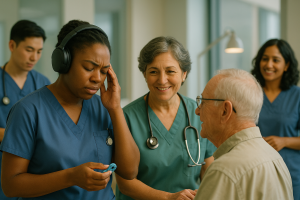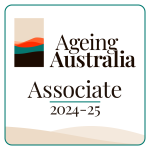Remote Patient Monitoring: Transforming Aged Care in 2025

Remote Patient Monitoring in Aged Care: Revolutionizing Elderly Healthcare
In an era of rapid technological advancement and an aging global population, the healthcare industry is undergoing a significant transformation. At the forefront of this revolution is Remote Patient Monitoring (RPM), a innovative approach that is reshaping the landscape of aged care. As we delve into the intricacies of RPM, we’ll explore how this technology is not only improving patient outcomes but also offering a cost-effective solution to the challenges faced by the healthcare system in caring for our elderly population.
The Rise of Remote Patient Monitoring in Aged Care
Remote Patient Monitoring has emerged as a game-changer in the healthcare industry, particularly in the realm of aged care. This technology allows healthcare providers to monitor patients’ vital signs and health status from a distance, enabling timely interventions and personalized care plans. The journey of RPM in aged care has been marked by significant milestones and accelerated adoption, especially in recent years.
Historical Development and Current Relevance
The concept of RPM in aged care began to take shape in the early 2000s, with initial implementations focusing on basic vital sign monitoring. However, it was the COVID-19 pandemic that catapulted RPM into the spotlight, accelerating its adoption across healthcare systems worldwide. The need for social distancing and the strain on healthcare resources during the pandemic highlighted the crucial role that RPM could play in maintaining continuity of care for vulnerable populations, particularly the elderly.
Today, the relevance and importance of RPM in aged care cannot be overstated. According to recent data, 80% of Americans view RPM favorably, with nearly half expressing strong support for its integration into medical care. This public endorsement is mirrored by the healthcare industry’s rapid adoption of RPM technologies. By 2024, it’s projected that 20% of large healthcare facilities will have implemented RPM solutions, marking a significant shift in how aged care is delivered.
Key Concepts of RPM in Aged Care
To fully appreciate the impact of RPM on aged care, it’s essential to understand its fundamental concepts:
- Real-time Data Collection: RPM systems continuously gather health data from patients, providing a comprehensive and up-to-date picture of their health status.
- Remote Monitoring of Vital Signs: Healthcare providers can track crucial health indicators such as heart rate, blood pressure, blood glucose levels, and oxygen saturation without the need for in-person visits.
- Early Intervention Capabilities: By analyzing trends in patient data, RPM systems can alert healthcare providers to potential issues before they escalate, enabling proactive care management.
These key features of RPM are transforming aged care by enabling more personalized, timely, and efficient healthcare delivery.
The Impact of RPM: Latest Statistics and Expert Insights
The adoption and impact of RPM in aged care are reflected in recent statistics and expert opinions:
Adoption Rates and Market Growth
- Physician Adoption: A remarkable 75% of physicians have embraced RPM for managing chronic health conditions, with 65% using it for medical management and 60% for care coordination.
- Patient Numbers: It’s anticipated that over 70 million Americans will be using RPM technologies by 2025, signaling a massive shift in healthcare delivery methods.
- Market Growth: The global RPM market is on a trajectory of exponential growth. Forecasts suggest an increase from USD 27.72 billion in 2024 to USD 56.94 billion by 2030, with a compound annual growth rate (CAGR) of 12.7%.
Expert Opinions on RPM Integration
Experts in the field of healthcare technology emphasize the transformative potential of RPM when integrated with other advanced technologies. Dr. Sarah Chen, a leading geriatric care specialist, notes, “The integration of RPM with AI and robotics is not just enhancing our ability to monitor patients remotely; it’s revolutionizing the entire concept of home care delivery. We’re seeing a reduction in unnecessary hospital visits and improved access to healthcare professionals, even in remote areas.”
Case Study: Medicare Enrollees
A compelling case study highlighting the rapid adoption of RPM is the dramatic increase in Medicare enrollees using these technologies. The number of Medicare beneficiaries utilizing RPM services skyrocketed from 55,000 in 2019 to 570,000 in 2022. This tenfold increase in just three years underscores the growing recognition of RPM’s value in managing the health of older adults.
Current Trends and Future Projections
As RPM continues to evolve, several key trends are shaping its future in aged care:
- Cloud-Based RPM Solutions: The shift towards cloud-based RPM platforms is gaining momentum. These solutions offer advantages such as seamless data integration, improved accessibility, and enhanced security measures.
- AI and Robotic Assistants in Home Care: The integration of artificial intelligence and robotic assistants with RPM is opening new frontiers in home care. These technologies can assist with daily activities, medication reminders, and even provide companionship to elderly patients.
- Increasing Demand Due to Aging Population: With the baby boomer generation entering their senior years, the demand for RPM in aged care is set to surge. By 2029, it’s estimated that there will be approximately 71.4 million Americans aged 65 and older, creating an unprecedented need for efficient and effective healthcare solutions.
Impact Analysis: The Benefits of RPM in Aged Care
The implementation of RPM in aged care has yielded significant benefits across various aspects of healthcare delivery:
Reduced Hospital Admissions
One of the most notable impacts of RPM has been the reduction in hospital admissions for chronic care complications. Studies have shown a decrease ranging from 19% to 41% across surveyed organizations. This reduction not only improves patient quality of life but also significantly alleviates the burden on healthcare systems.
Cost Efficiency
RPM has proven to be a cost-effective solution in aged care. For Medicare beneficiaries, delivering just 20 minutes of RPM per month can generate reimbursement of more than $1,000 over a 12-month period. This financial incentive, coupled with the reduction in hospital admissions, presents a compelling economic argument for the widespread adoption of RPM.
Healthcare Workforce Management
By enabling remote monitoring and reducing the need for frequent in-person visits, RPM helps in managing the workload of healthcare professionals more efficiently. This is particularly crucial in the context of the growing shortage of healthcare workers, especially in geriatric care.
Comparison with Alternatives
To fully appreciate the value of RPM in aged care, it’s important to compare it with alternative care methods:
| Method | Advantages | Disadvantages |
|---|---|---|
| RPM | Continuous monitoring, early intervention, cost-effective | Initial setup costs, potential technology barriers for some patients |
| Telehealth | Real-time video consultations, immediate feedback | Limited to visual assessments, requires stable internet connection |
| In-Person Care | Comprehensive physical examinations, immediate intervention | Higher costs, increased risk of hospital-acquired infections, less frequent monitoring |
| Wearable Devices (without RPM) | Continuous monitoring of vital signs, user-friendly | Lack of real-time professional feedback, limited to specific health metrics |
While each method has its merits, RPM stands out for its ability to provide continuous, professional monitoring without the need for constant in-person visits, making it particularly suitable for aged care.
Controversies and Debates
Despite its many benefits, the implementation of RPM in aged care is not without challenges and debates:
Privacy and Data Security Concerns
As RPM involves the collection and transmission of sensitive health data, concerns about privacy and data security are at the forefront of many discussions. Healthcare providers and technology companies must ensure robust security measures to protect patient information and comply with regulations like HIPAA.
Equity and Access Issues
There are ongoing debates about ensuring equitable access to RPM technologies, particularly for elderly patients in rural or underserved areas. Factors such as internet connectivity, technological literacy, and economic disparities can create barriers to RPM adoption for certain populations.
Implementing RPM in Aged Care: A Step-by-Step Guide
For healthcare providers looking to implement RPM in their aged care services, here’s a comprehensive guide:
-
Assess Organizational Readiness
– Evaluate current infrastructure and technological capabilities
– Identify key stakeholders and form an implementation team
– Determine budget and resource allocation
-
Choose Appropriate RPM Technologies
– Research available RPM platforms and devices
– Consider factors such as ease of use, data accuracy, and integration capabilities
– Consult with experts and vendors to select the best fit for your needs
-
Train Staff and Patients
– Develop comprehensive training programs for healthcare professionals
– Create user-friendly guides and tutorials for patients and caregivers
– Offer ongoing support and education to ensure smooth adoption
-
Establish Clear Communication Protocols
– Define procedures for data review and patient follow-up
– Set up alert systems for critical health indicators
– Establish channels for patient-provider communication
-
Monitor and Evaluate Program Effectiveness
– Set clear metrics for success (e.g., reduction in hospital admissions, patient satisfaction)
– Regularly review data and gather feedback from staff and patients
– Make iterative improvements based on outcomes and feedback
Frequently Asked Questions
What are the main benefits of RPM for elderly patients?
RPM offers continuous health monitoring, early detection of health issues, reduced need for hospital visits, and increased independence for elderly patients. It also provides peace of mind for family members and caregivers.
How does RPM impact healthcare costs in aged care?
RPM can significantly reduce healthcare costs by decreasing hospital admissions, enabling early interventions, and optimizing healthcare resource allocation. For Medicare beneficiaries, it can also generate substantial reimbursements.
Can RPM replace in-person visits entirely?
While RPM greatly reduces the need for in-person visits, it does not entirely replace them. Certain examinations and procedures still require face-to-face interactions. RPM complements rather than replaces traditional care methods.
What types of health conditions are best suited for RPM in aged care?
RPM is particularly effective for managing chronic conditions such as diabetes, hypertension, heart disease, and COPD. It’s also useful for post-operative care and monitoring patients at risk of falls.
How is patient data protected in RPM systems?
RPM systems employ various security measures including encryption, secure data transmission protocols, and access controls. Providers must ensure compliance with healthcare data protection regulations like HIPAA.
Challenges and Solutions in RPM Implementation
While RPM offers numerous benefits, its implementation in aged care faces several challenges. Here are some key issues and potential solutions:
Challenge: Technology Adoption by Elderly Patients
Many older adults may struggle with using new technologies, potentially limiting the effectiveness of RPM.
Solution: Develop user-friendly interfaces and comprehensive patient education programs. Involve family members or caregivers in the training process and provide ongoing support.
Challenge: Integration with Existing Healthcare Systems
Incorporating RPM into established healthcare infrastructures can be complex and time-consuming.
Solution: Invest in interoperable platforms that can easily integrate with existing electronic health record systems. Standardize data formats to ensure seamless information exchange across different platforms.
Challenge: Reimbursement Complexities
Navigating the reimbursement landscape for RPM services can be challenging for healthcare providers.
Solution: Stay informed about the latest reimbursement policies and advocate for comprehensive coverage. Work with policymakers to establish clear guidelines for RPM reimbursement in aged care.
Ethical Considerations and Best Practices
As RPM becomes more prevalent in aged care, it’s crucial to address ethical considerations and establish best practices:
- Informed Consent: Ensure that patients fully understand and consent to the use of RPM technologies. This includes explaining the data collected, how it will be used, and potential risks.
- Data Privacy and Security: Implement robust measures to protect patient data, including encryption, secure storage, and strict access controls.
- Balancing Technology with Human Care: While RPM offers numerous benefits, it’s important to maintain a balance with human interaction. Ensure that technology enhances rather than replaces personal care.
- Ensuring Equitable Access: Develop strategies to make RPM technologies accessible to all patients, regardless of their socioeconomic status or geographical location.
Success Stories in RPM Implementation
The implementation of RPM in aged care has led to numerous success stories:
- Reduction in Chronic Care Complications: Healthcare organizations using RPM have reported a 19% to 41% reduction in admissions for chronic care complications.
- Improved Patient Outcomes and Satisfaction: Patients using RPM often report feeling more engaged in their healthcare and having a better understanding of their conditions.
- Cost Savings: Both healthcare providers and patients have experienced significant cost savings through reduced hospital admissions and more efficient care delivery.
Tools and Resources for RPM in Aged Care
For those looking to implement or improve RPM systems in aged care, several tools and resources are available:
- Cloud-Based RPM Platforms: These offer scalable solutions for data collection, analysis, and patient management.
- AI-Powered Monitoring Devices: Advanced devices that can detect anomalies and predict potential health issues.
- Secure Data Transmission Protocols: Essential for ensuring the privacy and integrity of patient data.
- Patient Education Materials: Resources to help patients and caregivers understand and effectively use RPM technologies.
Conclusion: The Future of Aged Care
Remote Patient Monitoring is undeniably transforming the landscape of aged care. By enabling continuous health monitoring, facilitating early interventions, and reducing the burden on healthcare systems, RPM is improving the quality of life for elderly patients while offering a cost-effective solution to the challenges of an aging population.
As technology continues to advance and healthcare policies evolve to support RPM adoption, we can expect to see even more innovative applications in aged care. The integration of AI, robotics, and other emerging technologies with RPM holds the promise of creating a more personalized, efficient, and effective healthcare ecosystem for our elderly population.
For healthcare providers, policymakers, and technology developers, the message is clear: embracing and advancing RPM in aged care is not just an opportunity but a necessity. By doing so, we can ensure that our aging population receives the best possible care, maintaining their health, independence, and dignity in their golden years.
Additional Resources
For those seeking to delve deeper into the world of RPM in aged care, here are some valuable resources:
- Industry reports and market analyses:
- Government guidelines on RPM implementation:
- Academic research on RPM effectiveness in aged care:
By leveraging these resources and staying informed about the latest developments in RPM, healthcare providers and policymakers can continue to improve and expand the use of this transformative technology in aged care.











